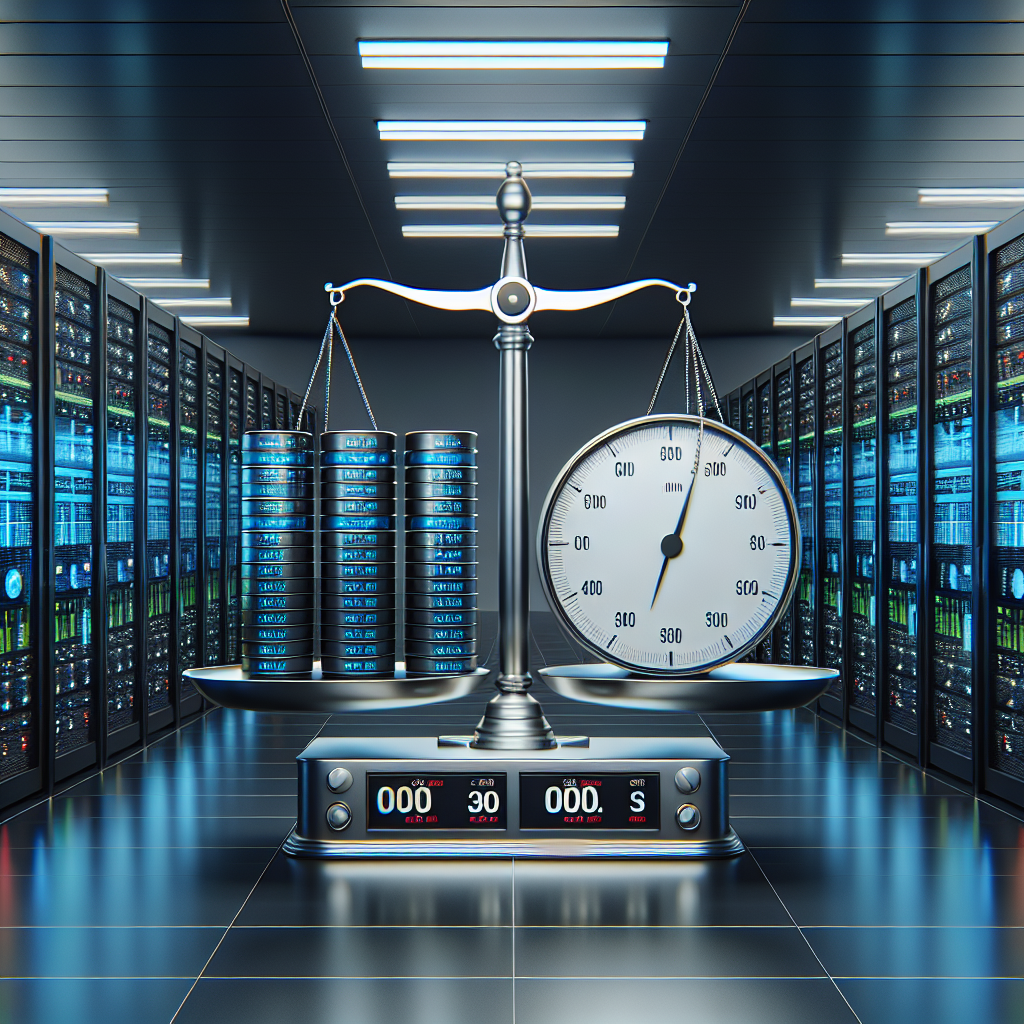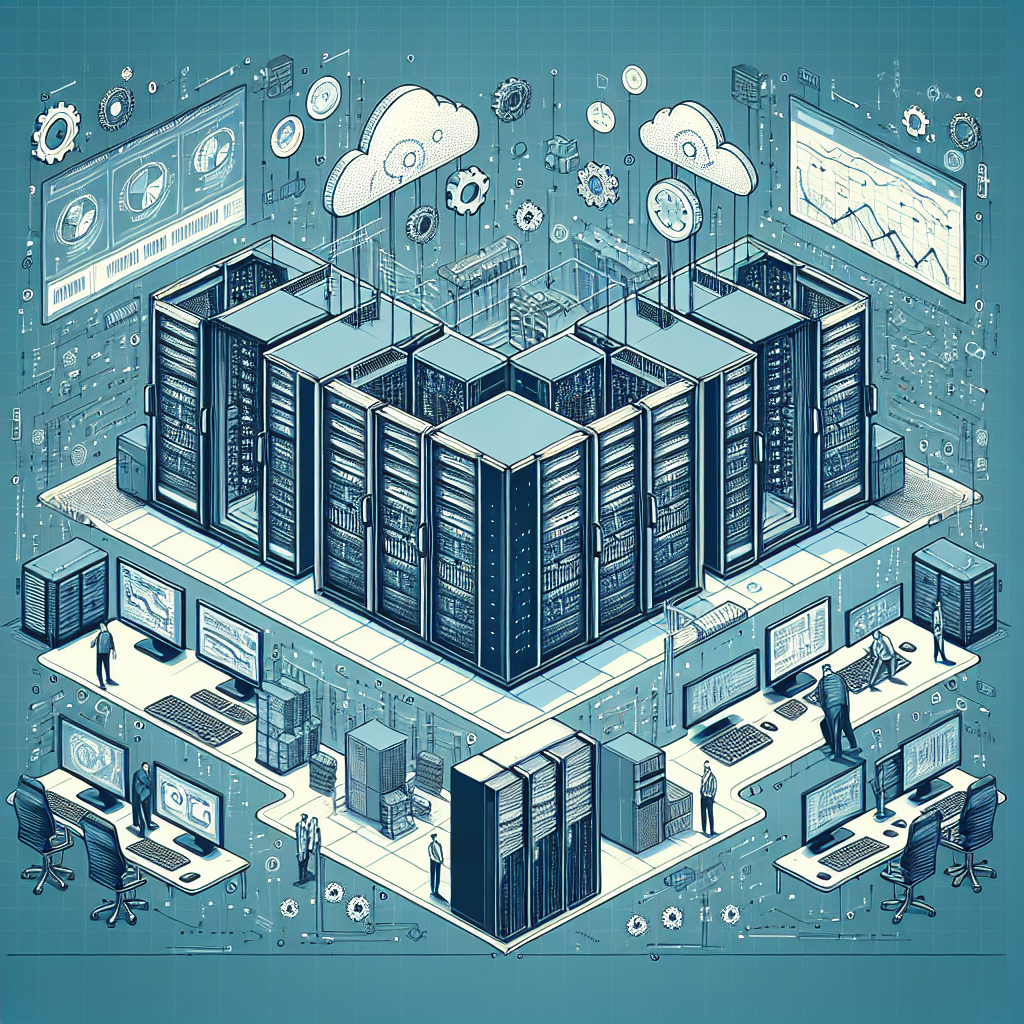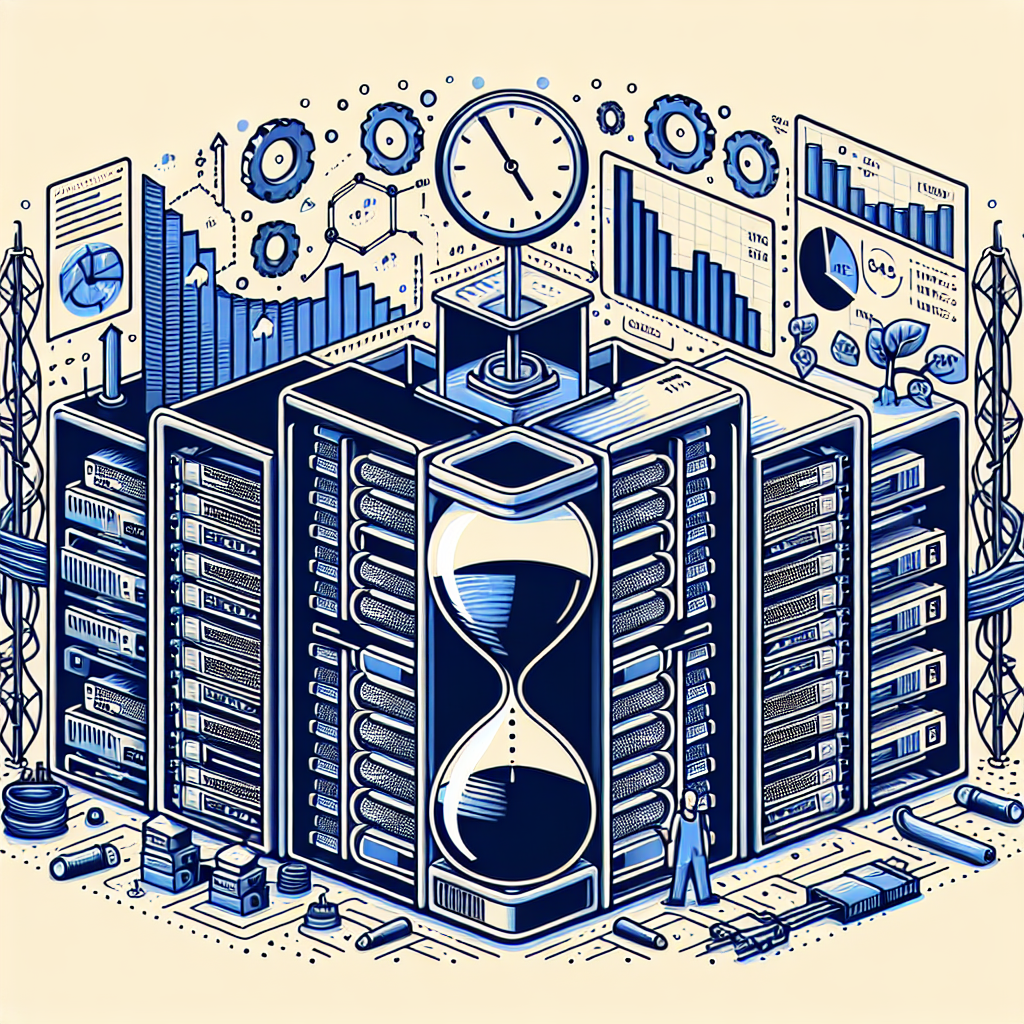Your cart is currently empty!
Tag: Data Center MTTR (Mean Time To Repair)

The Role of Automation and AI in Improving Data Center MTTR
Data centers play a crucial role in the functioning of modern businesses, serving as the backbone of their operations. As the volume and complexity of data continue to grow, the need for data centers to be efficient and reliable has become more important than ever. One key metric that data center operators focus on is Mean Time to Repair (MTTR), which measures the average time it takes to repair a system after a failure occurs.Traditionally, data center operators have relied on manual processes to identify and address issues that impact the performance and availability of their systems. However, with the increasing complexity of modern data centers, manual processes are no longer sufficient to meet the demands of today’s businesses. This is where automation and Artificial Intelligence (AI) come into play.
Automation and AI technologies have the potential to revolutionize the way data centers operate by streamlining processes and reducing the time it takes to identify and resolve issues. By automating routine tasks such as system monitoring, maintenance, and troubleshooting, data center operators can free up their time to focus on more strategic initiatives.
One of the key benefits of automation and AI in data centers is their ability to proactively detect and address issues before they impact the performance of systems. AI-powered monitoring tools can analyze vast amounts of data in real-time to identify patterns and anomalies that may indicate a potential issue. By detecting issues early on, data center operators can take corrective action before they escalate, reducing the MTTR and minimizing downtime.
In addition to proactive monitoring, automation can also play a crucial role in expediting the resolution of issues when they do occur. Automated workflows can be set up to automatically trigger alerts, assign tasks to the appropriate personnel, and initiate remediation actions. This not only speeds up the resolution process but also ensures consistency and accuracy in the way issues are addressed.
Furthermore, AI technologies such as machine learning can be used to predict potential failures based on historical data and patterns, enabling data center operators to take preventive action before issues occur. By leveraging AI algorithms, data center operators can optimize maintenance schedules, predict equipment failures, and improve overall system reliability.
In conclusion, automation and AI have the potential to significantly improve data center MTTR by streamlining processes, proactively detecting issues, and expediting issue resolution. By harnessing the power of these technologies, data center operators can enhance the efficiency, reliability, and performance of their systems, ultimately ensuring the smooth functioning of their businesses.

Benchmarking Data Center MTTR: How Does Your Organization Compare?
Benchmarking Data Center MTTR: How Does Your Organization Compare?Mean Time To Repair (MTTR) is a critical metric for any data center operation. It measures the average time it takes to restore a failed system back to normal operation. A low MTTR indicates that a data center is efficient at diagnosing and resolving issues quickly, minimizing downtime and ensuring that critical services remain available.
Benchmarking your data center’s MTTR against industry standards can provide valuable insights into the efficiency of your operations and help identify areas for improvement. By comparing your organization’s MTTR to industry benchmarks, you can gauge how well you are performing relative to your peers and competitors.
So, how does your organization compare when it comes to Data Center MTTR benchmarking? Here are a few key factors to consider:
1. Industry Standards: Industry benchmarks for Data Center MTTR can vary depending on the size and complexity of the data center operation. For example, a larger data center with more resources and redundancy may have a lower MTTR target compared to a smaller data center with limited resources. It’s important to research industry standards and best practices to determine an appropriate benchmark for your organization.
2. Internal Metrics: In addition to industry benchmarks, it’s important to track and analyze your organization’s internal MTTR metrics. By monitoring the time it takes to resolve issues and comparing it to your target goals, you can identify trends and patterns that may impact your data center’s efficiency.
3. Root Cause Analysis: Understanding the root causes of downtime is crucial for improving MTTR performance. By conducting thorough root cause analysis for each outage or failure, you can identify recurring issues, implement preventative measures, and reduce the likelihood of future disruptions.
4. Continuous Improvement: Benchmarking Data Center MTTR is not a one-time exercise. It requires ongoing monitoring, analysis, and improvement to ensure that your organization remains competitive and efficient in resolving issues. By continuously measuring and comparing your MTTR performance, you can identify areas for improvement and implement proactive measures to reduce downtime and improve overall operational efficiency.
In conclusion, Benchmarking Data Center MTTR is a valuable tool for assessing the efficiency of your data center operations and identifying opportunities for improvement. By comparing your organization’s MTTR performance against industry standards and best practices, you can gain valuable insights into your operational efficiency and take proactive steps to minimize downtime and ensure the availability of critical services. Remember, continuous monitoring and improvement are key to maintaining a competitive edge in today’s fast-paced data center environment.

Ensuring Data Center Resilience: Strategies for Lowering MTTR
Data centers are the backbone of modern businesses, providing the infrastructure necessary to store, process, and distribute vast amounts of data. As businesses increasingly rely on data for their operations, ensuring the resilience of data centers has become a critical priority. One key aspect of data center resilience is minimizing Mean Time to Repair (MTTR), which refers to the average time it takes to repair a system after a failure occurs. Lowering MTTR is essential for minimizing downtime and ensuring business continuity.There are several strategies that organizations can implement to lower MTTR and increase data center resilience. One of the most effective ways to achieve this is through proactive monitoring and maintenance. By regularly monitoring the performance and health of data center equipment, organizations can identify potential issues before they escalate into full-blown failures. This allows IT teams to address problems early on, reducing the time it takes to repair them.
Another key strategy for lowering MTTR is implementing redundancy and failover systems. By having backup systems in place, organizations can quickly switch over to a secondary system in the event of a failure, minimizing downtime and reducing the impact on business operations. Redundancy can be applied to various components of the data center, including power supplies, cooling systems, and networking equipment.
Regular testing and disaster recovery planning are also crucial for lowering MTTR. By conducting regular tests of disaster recovery procedures, organizations can identify any weaknesses in their systems and processes, allowing them to make improvements before a real disaster occurs. Having a well-defined and tested disaster recovery plan in place can significantly reduce the time it takes to recover from a data center failure.
Additionally, investing in automation and remote management tools can help organizations lower MTTR by streamlining the repair process. Automation can help IT teams quickly identify and resolve issues, while remote management tools allow for remote monitoring and maintenance of data center equipment, reducing the need for physical intervention.
Overall, ensuring data center resilience and lowering MTTR requires a combination of proactive monitoring, redundancy, disaster recovery planning, and automation. By implementing these strategies, organizations can minimize downtime, protect critical data, and ensure the continuity of their business operations. In an increasingly data-driven world, data center resilience has never been more important.

The Impact of Data Center MTTR on Business Continuity and Disaster Recovery Plans
In today’s digital age, data centers play a crucial role in ensuring the smooth operation of businesses. These facilities house the servers and storage systems that store and process large amounts of data essential for day-to-day operations. However, data centers are not immune to issues such as hardware failures, power outages, or natural disasters that can disrupt operations and lead to downtime.One key metric that organizations need to consider when assessing their data center’s resilience is Mean Time to Repair (MTTR). MTTR measures the average time it takes to repair a failed system and restore it to full functionality. A low MTTR indicates that issues are quickly identified and resolved, minimizing the impact on operations and reducing downtime.
The impact of data center MTTR on business continuity and disaster recovery plans cannot be understated. A high MTTR can lead to extended periods of downtime, resulting in lost revenue, decreased productivity, and damage to the organization’s reputation. In the event of a disaster or major system failure, a lengthy MTTR can significantly impact the ability of the organization to recover and continue operations.
To mitigate the impact of data center MTTR on business continuity and disaster recovery plans, organizations should focus on proactive measures to improve system reliability and reduce downtime. This includes regular maintenance and monitoring of data center equipment, implementing redundancy and failover mechanisms, and investing in robust disaster recovery solutions.
Additionally, organizations should conduct regular testing and simulation exercises to identify weaknesses in their data center infrastructure and processes. By proactively addressing these issues, organizations can minimize the impact of downtime and ensure that critical systems are quickly restored in the event of a failure.
In conclusion, the impact of data center MTTR on business continuity and disaster recovery plans is significant. Organizations must prioritize reducing MTTR through proactive measures to ensure the resilience of their data center infrastructure and minimize the impact of downtime on operations. By investing in reliable systems, implementing robust disaster recovery solutions, and conducting regular testing, organizations can mitigate the risks associated with data center failures and ensure business continuity in the face of unforeseen events.

Case Study: How a Company Reduced Data Center MTTR by Implementing Best Practices
In today’s fast-paced business environment, downtime in data centers can have a significant impact on a company’s bottom line. When a data center experiences an outage, it can result in lost revenue, decreased productivity, and damage to a company’s reputation. In order to minimize downtime and reduce Mean Time to Recovery (MTTR), companies must implement best practices to ensure their data centers are running smoothly and efficiently.One company that successfully reduced its data center MTTR by implementing best practices is ABC Corp. ABC Corp is a global technology company that provides cloud-based solutions to businesses around the world. With a growing customer base and increasing demand for its services, ABC Corp knew that downtime in its data centers was not an option. After experiencing several outages that resulted in lost revenue and dissatisfied customers, ABC Corp’s leadership team decided to take action.
ABC Corp began by conducting a comprehensive audit of its data center infrastructure to identify any potential vulnerabilities or areas for improvement. The audit revealed that ABC Corp’s data center was not operating at optimal efficiency, with outdated equipment and inefficient processes contributing to increased downtime. In order to address these issues, ABC Corp implemented a series of best practices to improve the reliability and performance of its data center.
One of the first steps ABC Corp took was to upgrade its hardware and software to ensure that its data center was running on the latest technology. By investing in new servers, storage devices, and networking equipment, ABC Corp was able to improve the overall performance of its data center and reduce the likelihood of outages. Additionally, ABC Corp implemented a comprehensive monitoring system that allowed its IT team to proactively identify and address any potential issues before they escalated into major problems.
ABC Corp also focused on improving its disaster recovery capabilities to minimize downtime in the event of a catastrophic failure. By implementing redundant systems and backup solutions, ABC Corp was able to quickly recover from any outages and minimize the impact on its customers. Additionally, ABC Corp established clear communication protocols and escalation procedures to ensure that all stakeholders were informed and involved in the recovery process.
As a result of these initiatives, ABC Corp was able to significantly reduce its data center MTTR and improve the overall reliability of its infrastructure. By implementing best practices and investing in the latest technology, ABC Corp was able to minimize downtime and ensure that its data center was operating at peak efficiency. This not only improved customer satisfaction but also helped ABC Corp maintain its competitive edge in the market.
In conclusion, reducing data center MTTR requires a proactive approach and a commitment to implementing best practices. By investing in the latest technology, improving disaster recovery capabilities, and establishing clear communication protocols, companies can minimize downtime and ensure that their data centers are running smoothly and efficiently. ABC Corp’s success story serves as a valuable example for other companies looking to improve the reliability and performance of their data centers.

Optimizing Data Center Operations: Improving MTTR Through Proactive Maintenance
In today’s digital age, data centers play a crucial role in the functioning of businesses and organizations. These facilities house and manage the servers, storage, and networking equipment that support the flow of data and information throughout an organization. As such, ensuring the optimal performance and efficiency of a data center is essential for the smooth operation of a business.One key aspect of data center operations is minimizing Mean Time to Repair (MTTR), which refers to the average time it takes to repair a system or component after a failure occurs. A high MTTR can lead to downtime, loss of productivity, and ultimately, decreased revenue for a business. To address this challenge, data center operators can adopt proactive maintenance strategies to optimize their operations and reduce MTTR.
Proactive maintenance involves identifying and addressing potential issues before they escalate into full-blown failures. By regularly monitoring and maintaining equipment, data center operators can prevent unexpected downtime and reduce the time it takes to repair any issues that do arise. Here are some tips for optimizing data center operations and improving MTTR through proactive maintenance:
1. Implement a comprehensive monitoring system: Utilize monitoring tools and software to track the performance of servers, storage devices, and networking equipment in real-time. By monitoring key metrics such as temperature, power usage, and network traffic, data center operators can proactively identify potential issues and take corrective action before they lead to downtime.
2. Conduct regular inspections and maintenance: Schedule routine inspections and maintenance tasks to ensure that equipment is functioning properly and in good condition. This may include cleaning dust and debris from servers, replacing worn-out components, and testing backup systems to ensure they are operational in case of a failure.
3. Create a maintenance schedule: Develop a maintenance schedule that outlines regular tasks and intervals for conducting maintenance activities. This can help data center operators stay on top of maintenance tasks and ensure that equipment is well-maintained and operating efficiently.
4. Invest in predictive maintenance technologies: Consider implementing predictive maintenance technologies, such as machine learning algorithms and predictive analytics, to forecast potential equipment failures before they occur. By analyzing historical data and identifying patterns and trends, predictive maintenance can help data center operators anticipate issues and take proactive measures to prevent downtime.
5. Train staff on best practices: Provide training and education for data center staff on best practices for maintenance and operations. By ensuring that staff are knowledgeable and skilled in maintaining equipment and troubleshooting issues, data center operators can improve efficiency and reduce MTTR.
By adopting proactive maintenance strategies and optimizing data center operations, businesses can minimize downtime, improve productivity, and ultimately, enhance their bottom line. By investing in monitoring tools, conducting regular inspections, creating maintenance schedules, leveraging predictive maintenance technologies, and training staff on best practices, data center operators can improve MTTR and ensure the smooth functioning of their data center operations.

Reducing Downtime: How to Decrease Data Center MTTR
Downtime in a data center can be a costly and frustrating experience for businesses. It not only disrupts operations but can also lead to financial losses and damage to reputation. One of the key metrics used to measure the efficiency of a data center is the Mean Time to Repair (MTTR), which is the average time taken to restore services after an outage.Reducing MTTR is crucial for minimizing downtime and ensuring smooth operations of a data center. Here are some strategies that can help decrease data center MTTR:
1. Implement proactive monitoring: Monitoring systems can help detect issues before they cause downtime. By keeping an eye on key performance indicators and alerting staff to potential problems, IT teams can take preemptive action to prevent outages.
2. Invest in automation: Automation tools can streamline the troubleshooting process and help resolve issues faster. Automated scripts can be used to perform routine tasks, identify problems, and even implement fixes without human intervention.
3. Train staff: Well-trained and knowledgeable staff are essential for quick and effective problem resolution. Investing in training programs for IT personnel can help them understand the infrastructure better and respond efficiently to issues.
4. Create a comprehensive incident response plan: Having a well-defined incident response plan in place can help teams act quickly and effectively during an outage. The plan should outline roles and responsibilities, escalation procedures, and steps to be taken to restore services.
5. Conduct regular maintenance: Regular maintenance and checks can help identify potential issues early on and prevent them from causing downtime. Scheduled maintenance tasks should be planned and executed to keep the data center running smoothly.
6. Implement redundancy and failover mechanisms: Redundant systems and failover mechanisms can help minimize downtime by ensuring that services are automatically switched to backup systems in case of a failure. This can help maintain continuity of operations and reduce the impact of outages.
By implementing these strategies, data center operators can reduce MTTR and minimize downtime, ensuring that their operations run smoothly and efficiently. Investing in proactive monitoring, automation, staff training, incident response planning, maintenance, and redundancy can help businesses maintain high availability and reliability of their data center services.

Maximizing Efficiency: Strategies for Improving Data Center MTTR
In today’s fast-paced digital world, data centers play a crucial role in ensuring the smooth functioning of businesses and organizations. However, with the increasing complexity of data center operations, downtime can have a significant impact on productivity and revenue. One key metric that data center managers focus on is Mean Time to Repair (MTTR), which measures the average time it takes to repair a system after a failure.Maximizing efficiency and reducing MTTR is essential for data center managers to ensure minimal downtime and maximum uptime. Here are some strategies for improving data center MTTR:
1. Implement proactive maintenance: Regular maintenance and monitoring of data center equipment can help prevent potential failures before they occur. By conducting routine checks and addressing any issues promptly, data center managers can reduce the likelihood of unexpected downtime and minimize MTTR.
2. Invest in monitoring tools: Utilizing advanced monitoring tools and software can provide real-time insights into the health and performance of data center systems. By continuously monitoring key metrics such as temperature, humidity, and power usage, data center managers can proactively address any issues that may arise and minimize MTTR.
3. Establish clear escalation procedures: In the event of a system failure, having clear escalation procedures in place can help streamline the repair process and reduce MTTR. By outlining responsibilities and communication protocols, data center managers can ensure that the right personnel are notified promptly and can take immediate action to resolve the issue.
4. Conduct regular training: Providing training to data center staff on troubleshooting techniques and best practices can help improve response times and reduce MTTR. By equipping staff with the necessary skills and knowledge, data center managers can ensure a swift and efficient resolution to any issues that may arise.
5. Implement redundancy and failover mechanisms: Redundancy and failover mechanisms can help minimize downtime in the event of a system failure. By implementing backup systems and automatic failover processes, data center managers can ensure that critical operations can continue uninterrupted, reducing MTTR significantly.
In conclusion, maximizing efficiency and reducing MTTR in data centers is essential for ensuring minimal downtime and maximum uptime. By implementing proactive maintenance, investing in monitoring tools, establishing clear escalation procedures, conducting regular training, and implementing redundancy and failover mechanisms, data center managers can improve their MTTR and ensure the smooth functioning of their operations. By prioritizing efficiency and taking proactive measures, data center managers can minimize downtime and maximize productivity.

Mitigating Risks and Improving Data Center MTTR Through Proactive Maintenance
Mitigating Risks and Improving Data Center MTTR Through Proactive MaintenanceIn today’s digital age, data centers play a crucial role in the functioning of businesses and organizations. These facilities house servers, storage systems, networking equipment, and other critical infrastructure that enable the processing and storage of vast amounts of data. As such, any downtime or disruption in a data center can have a significant impact on operations, leading to potential financial losses and damage to reputation.
To minimize the risks associated with data center downtime and improve Mean Time To Repair (MTTR), proactive maintenance is essential. Proactive maintenance involves regularly monitoring, maintaining, and optimizing data center infrastructure to prevent issues before they occur. By taking a proactive approach to maintenance, organizations can identify potential problems early on, address them promptly, and reduce the likelihood of unexpected downtime.
There are several key strategies that organizations can implement to mitigate risks and improve MTTR through proactive maintenance:
1. Regularly scheduled maintenance: Establishing a regular maintenance schedule for data center equipment is crucial for ensuring optimal performance and reliability. This includes tasks such as cleaning, inspecting, and testing equipment, as well as performing firmware updates and software patches. By staying on top of maintenance tasks, organizations can identify and address potential issues before they escalate into major problems.
2. Monitoring and alerting systems: Implementing monitoring and alerting systems that track the performance and health of data center equipment can help organizations proactively identify issues and respond quickly. These systems can provide real-time alerts when equipment is operating outside of normal parameters, allowing IT teams to take immediate action to prevent downtime.
3. Predictive analytics: Leveraging predictive analytics tools can enable organizations to forecast potential equipment failures and prioritize maintenance activities accordingly. By analyzing historical performance data and trends, organizations can identify patterns that indicate when equipment is likely to fail and take proactive measures to address these issues before they impact operations.
4. Disaster recovery planning: Developing a comprehensive disaster recovery plan is essential for mitigating risks and minimizing downtime in the event of a data center failure. Organizations should regularly test and update their disaster recovery plans to ensure that they are effective and can be implemented quickly in the event of an emergency.
By implementing proactive maintenance strategies, organizations can reduce the risks associated with data center downtime and improve MTTR. By staying ahead of potential issues and taking a proactive approach to maintenance, organizations can ensure that their data center infrastructure remains reliable, efficient, and resilient in the face of unexpected challenges. Ultimately, investing in proactive maintenance can help organizations minimize downtime, protect their valuable data, and maintain their competitive edge in today’s digital landscape.

Ensuring Data Center Resilience: Strategies for Faster MTTR
In today’s digital age, data centers play a crucial role in ensuring the smooth operation of businesses and organizations. Data centers house the critical infrastructure that supports the storage, processing, and dissemination of data, making them essential for the functioning of modern enterprises. However, data centers are not immune to disruptions and downtime, which can have severe consequences for businesses.One of the key challenges faced by data center operators is the need to ensure resilience and minimize downtime. Mean Time to Repair (MTTR) is a critical metric that measures the average time it takes to restore operations after a failure or outage. Faster MTTR is essential for minimizing the impact of disruptions and ensuring the continuity of operations.
There are several strategies that data center operators can implement to improve MTTR and enhance resilience:
1. Implementing Redundancy: Redundancy is a key component of resilience in data centers. By having redundant systems, components, and infrastructure in place, operators can ensure that operations can continue even in the event of a failure. Redundancy can help to minimize downtime and speed up the recovery process.
2. Monitoring and Maintenance: Regular monitoring and maintenance of data center infrastructure are essential for identifying potential issues before they escalate into full-blown failures. By proactively monitoring systems and conducting regular maintenance, operators can prevent downtime and reduce MTTR.
3. Automation: Automation can help to streamline operations and speed up the recovery process in the event of a failure. By automating routine tasks and processes, operators can reduce the risk of human error and ensure faster response times to incidents.
4. Disaster Recovery Planning: Having a robust disaster recovery plan in place is essential for ensuring resilience in data centers. A well-defined plan that outlines the steps to be taken in the event of a failure can help to minimize downtime and ensure a faster recovery.
5. Training and Skill Development: Ensuring that data center staff are well-trained and equipped with the necessary skills is essential for improving MTTR. By investing in training and skill development, operators can ensure that staff are prepared to respond effectively to incidents and minimize downtime.
In conclusion, ensuring data center resilience and faster MTTR is essential for maintaining the continuity of operations and minimizing the impact of disruptions. By implementing strategies such as redundancy, monitoring, automation, disaster recovery planning, and training, data center operators can enhance resilience and improve their ability to recover quickly from failures. Investing in resilience is crucial for ensuring the smooth operation of data centers and the success of businesses in today’s digital landscape.
